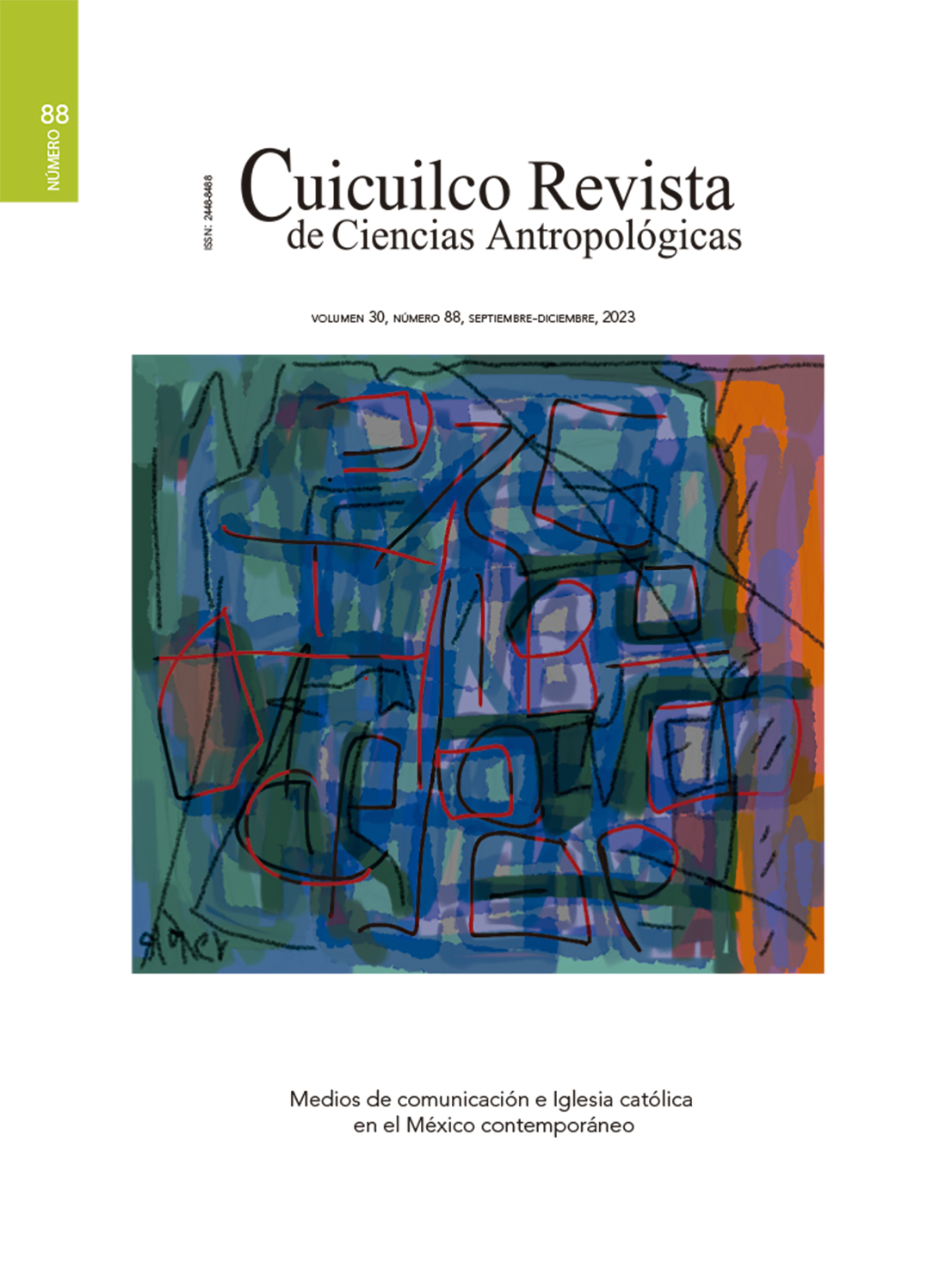Catholic E-Vangelization and Web 2.0 during Pandemic time in Mexico
Keywords:
E-vangelization, TikTok, spirituality, pandemic, Catholic church.Abstract
In Mexico, even before the health emergency caused by the SARS-CoV-2 pandemic, some priests, religious men, and women chose to bring the gospel to digital social networks. One of them is the famous Chinese short-form video hosting service: TikTok. The phenomenon studied is alive, so new methodological tools and methods are needed to analyze it. In this article, I used new tools and methods of digital ethnography and text analysis to understand the production of content and the reactions of the faithful through the analysis of two cases of Catholictokeros originally from Mexico: Sister Judith and Father Borre. The health emergency came to accelerate an already existing process. The institutional effort of the Catholic Church in these times of health emergency has been plural and diverse both in the digital and analog world.
Downloads
References
Asociación de Internet MX
(2021) 17° Estudio sobre los Hábitos de los Usuarios de Internet en México 2021. Asociación de Internet MX, mayo. <https://irp.cdn-website.com/81280eda/files/uploaded/17%C2%B0%20Estudio%20sobre%20los%20Ha%CC%81bitos%20de%20los%20Usuarios%20de%20Internet%20en%20Me%CC%81xico%202021%20v16%20Publica.pdf>. Consultado el 14 de mayo de 2023.
Bauman, Zygmunt
(2010) Vida liquida, estado y sociedad, 143. Paidós. Barcelona.
Babin, Pierre y Marshall McLuhan
(1978) Autre homme, autre chrétien à l’âge électronique. Chatelet. Lyon.
Benedicto XVI
(2010) El sacerdote y la pastoral en el mundo digital: los nuevos medios al servicio de la Palabra. Mensaje del Santo Padre Benedicto XVI, para la XLIV Jornada Mundial de las Comunicaciones Sociales, domingo 16 de mayo. <https://w2.vatican.va/content/benedict-xvi/es/messages/communications/documents/hf_ben-xvi_mes_20100124_44th-world-communications-day.html>. Consultado el 14 de mayo de 2023.
Berners Lee, Tim
(2017) Three Challenges for the Web. Web Foundation, 12 de marzo. <http://webfoundation.org/2017/03/web-turns-28-letter/#VersionES>. Consultado el 14 de mayo de 2023.
Campbell, Heidi
(2010) When religion meet new media. Routledge. Londres.
Cheong, Pauline Hope et al.
Digital religion, social media, and culture: perspectives, practices, and futures, Pauline Hope Cheong et al. (eds.). Peter Lang. Nueva York.
Da Silva Moreira, Alberto et al. (Org.)
(2012) A religião na mídia e a mídia na religião, Alberto Da Silva Moreira, Carolina Teles Lemos y Eduardo de Gusmão Quadros (org.). Gráfica e editora América. Goiânia.
DLF Redacción
(2022) 7 tiktokers católicos que vale la pena seguir. Desde la Fe, 11 de febrero. México. <https://desdelafe.mx/noticias/sabias-que/5-tiktokers-catolicosque-vale-la-pena-seguir/>. Consultado el 4 de noviembre de 2023.
Einstein, Mara
(2008) Brand of faith. Routledge. Londres.
Odgers Ortiz, Olga et al.
(2020) Encuesta sobre Coronavirus, Bienestar y Religiosidad (cobire). Documentos de contingencia 13. El Colegio de la Frontera, CONACYT. Tijuana, México; 37. <https://www.colef.mx/wp-content/uploads/2020/07/13_Cobirenoviembre.pdf>. Consultado el 14 de mayo de 2023.
McLuhan, Marshall
(1999) The medium and the light: reflections on religion, Eric McLuhan y Jacek Szklarek. Wipfe & Stock. Eugene.
Murugesan, San
(2007) Understanding Web 2.0. IT Professional, 9 (4), julio-agosto: 34-41. . Consultado el 14 de mayo de 2023.
Quick, Martin Luther
(2021) e-Vangelism: Creating and implementing a Social Media Ministry for Outreach.
QuickTakes. EE.UU.
Spadaro, Antonio
(2014a) Ciberteologi?a Pensar el cristianismo en tiempos de la red, Antonio Martínez Riu (trad.). Herder. Barcelona.
(2014b) Cybertheology, Thinking Christianity in the Era of the Internet, María Way (trad.). Fordham University Press. Nueva York.
Solís Nicot, Yves Bernardo Roger
(2015) De la centralización romana a la descentralización de las redes sociales: la promoción de la figura de Luis María Martínez, Siervo de Dios, en la Web 2.0. Intersticios Sociales, 5 (10), septiembre. Guadalajara [YouTube]. <http://www.intersticiossociales.com/ediciones/numero_10.html> o <http://www.redalyc.org/articulo.oa?id=421741049001>. Consultado el 14 de mayo de 2023.
(2017) Visual and Dynamic Hagiographies: the use of YouTube for the Promotion of Saints in Kids. Revista Caminhos-Revista de Ciências da Religião, Goiânia, 15 (2): 170-193. <http://seer.pucgoias.edu.br/index.php/caminhos/article/view/6005>. Consultado el 11 de julio de 2022.
(2020) Hagiografías en la era de la Web 2.0. Historia y Grafía, (54), 3 de enero: 193-230, 3 de enero. <https://www.revistahistoriaygrafia.com.mx/index.php/HyG/article/view/282>. Consultado el 14 de mayo de 2023.
Wagner, Rachel
(2012) Godwired. Religion, ritual and Virtual reality. Routledge. Londres.
Downloads
Published
Versions
- 2024-03-13 (2)
- 2023-11-22 (1)







